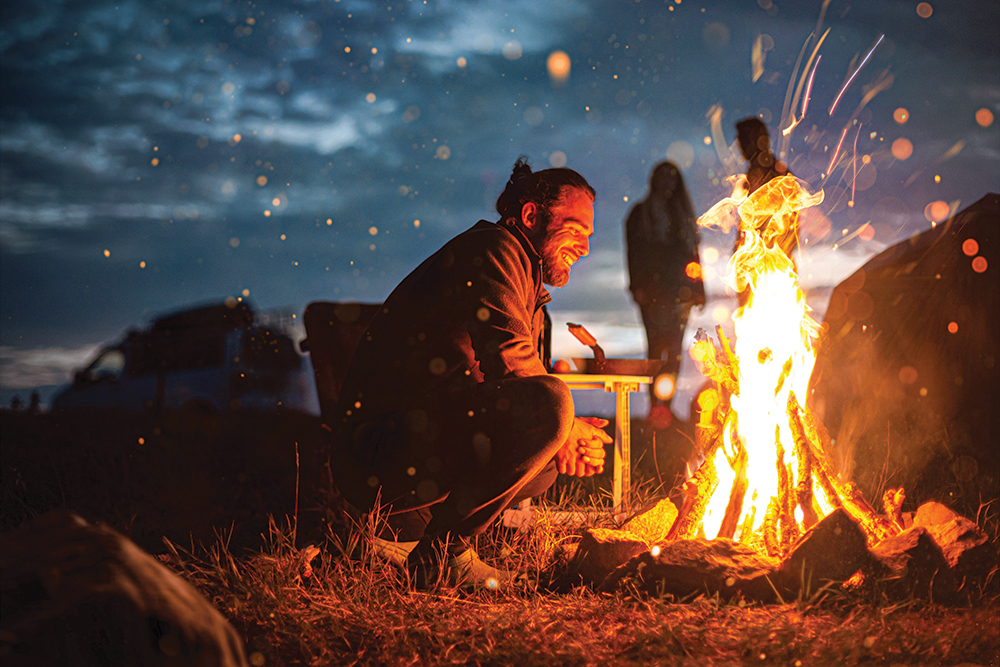KEEP YOUR HOME FIRE BURNING.
Editor’s Note: This is one of three sections about Fire we published on our Spring/Summer 2021 Prepper Manual. The other two sections are Light it Up! and The Flame Game.
Without a doubt, fire is one of our most important assets in a survival situation. It’ll keep us warm, staving off hypothermia. We can use it to boil water, rendering it safer to drink so we can avoid dehydration. And, of course, a warm meal is always better than cold mush.
On top of all that, there’s a psychological element at work: We’re not only comforted by the fire as it lights up the night and keeps the “bogeyman” at bay, being able to light and tend the fire also gives us something practical we can accomplish. Even if every other thing seems to be going wrong, at least we have some control over this.
Carry with you a couple of ways—at minimum—to get a fire going, just in case one of them fails or is lost or damaged.

1.0 FIRE TRIANGLE
There are three things that must be present for successful combustion to take place. The absence of any one of them will mean failure. Some people refer to this as the “fire triangle.”
1.1 Oxygen
Fire needs to breathe. Smothering the fire by adding too much too fast is one of the most common mistakes people make. Take your time and let the fire get some air.
1.2 Fuel
Fire needs something to burn. This process normally starts with tinder and then moves to kindling before finally adding larger branches or logs.
1.3 Heat
Fire needs heat or a spark in order to start the process. This could be from friction, such as a bow drill, or via any number of modern implements.

2.0 FIRE-STARTERS
There are many tools available to the survivalist that will aid in getting a fire going quickly and easily.
2.1 Disposable Lighter
Probably the most common, and certainly the easiest to use, is the simple disposable lighter. Roll the thumb wheel, and you have instant flame. However, it doesn’t work well when the weather’s wet or cold.
2.2 Ferrocerium Rod
When scraped, a ferro rod will rain sparks onto the tinder, hopefully igniting it. These rods come in a range of sizes, from necklace charms to several inches long.
2.3 Flint and Steel
For centuries, mankind has used metal and rock to start fires. Strike the steel with a shard of flint, and tiny shards of metal are carved off, ignited by the friction.
2.4 Stormproof Matches
Because they’re limited to one-time use and typically require a special strike strip that could get lost or fouled, stormproof matches aren’t the best option. However, they can serve as a decent backup tool.

2.5 Solar Power
A Fresnel lens is a flat magnifying lens made with a succession of concentric circles or rings. The lens is thin and usually somewhat flexible. It works well to concentrate the sun’s rays onto tinder.
3.0 PRIMITIVE METHODS
Human beings developed a few different ways to get a fire going before the development of modern tools.
3.1 Bow Drill
The principle is simple; the execution can be difficult. Spin the end of a rod against a board fast enough to generate friction sufficient to create a burning coal or ember. This isn’t a method to rely on without a lot of practice first.
3.2 Fire Plough
Another friction method, a fire plough involves rubbing the end of a stick back and forth in a groove of a flat piece of wood, generating dust that turns into an ember and eventually ignites.
4.0 UNCONVENTIONAL METHODS
While these aren’t recommended as primary means of fire-lighting, they can work in a pinch if you have the right gear.

4.1 Steel Wool and Battery
The finer the steel wool, the better. Simply touch the terminals of a 9-volt battery to the wool, and it’ll quickly heat to several hundred degrees—glowing hot and ready to ignite your kindling.
4.2 Road Flare
Ignite a road flare and it’ll burn very hot, getting your kindling and branches going rather easily in most cases. However, this is a one-and-done method, so make it count.
5.0 TINDER
It’s important to keep tinder in your fire kit in case you can’t find any natural material to use. Kindling and other fuel will have to be sourced in the wild.
5.1 Cotton Balls
One of the cheapest and easiest DIY options is to combine cotton balls with petroleum jelly, mashing them together in a plastic bag. Use one cotton ball, fluff it up, and light it.
5.2 Dryer Lint
This is a suitable substitute for cotton balls, provided your laundry consists of mostly cotton or other natural fabrics. Lint from man-made materials such as polyester will just melt.
5.3 Store-Bought Options
There are several types of manufactured tinder that come in all manner of sizes and shapes—from cubes that’ll light, even when wet, to paracord with strands of tinder hidden inside. Play around with different options until you find ones that work well for you and your chosen fire-lighting methods.
Editor’s note: A version of this article first appeared in the Prepper Spring/Summer, 2021 print issue of American Survival Guide.


